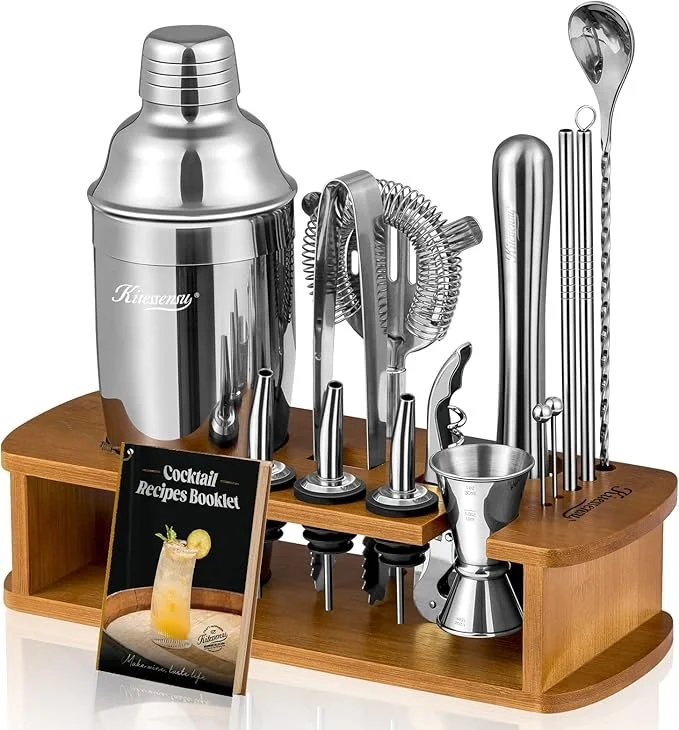A Classic Gin Martini
A martini is the epitome of sophistication. And what could be more classic than a gin martini? This timeless cocktail is the perfect balance of smooth gin and dry vermouth, with a hint of bitterness from the olives. If you're looking to impress your guests (or yourself), look no further than this classic recipe.
Why I love a martini…
To me, A martini always feels like an earned drink. Whether you’re celebrating a win, or sipping away a rough day, you can always feel the chill of the first sip of a martini in your veins.
Gin martinis are my personal favorite, but if you’re more of a vodka fan the gin in this recipe can easily be swapped to your liking.
My martini rules
Back in my New York City cocktail waitressing days, a very well-dressed older gentleman ordered a martini from me and said “ask the bartender to make it so cold you could ice skate on it.” This phrase has never left my head, and I’ve used it many times when ordering my own martinis.
Martinis are meant to be enjoyed very cold. At a good bar, they’ll swap out your martini glass for a chilled one when it loses its frost. My rule when making martinis at home is to shake for as long as I can until the shaker literally feels like it’s giving me frostbite… and then a few more seconds after that!
What ingredients are needed to make a gin martini?
To create the perfect gin martini, you'll need the following ingredients:
Quality gin
Quality Dry vermouth
Orange bitters
Twist of lemon peel or olives for garnish
Ice cubes
What Bar tools do I need to make a gin martini?
To make a gin martini, you'll need the following bar tools:
Cocktail shaker or mixing glass
Jigger or measuring cup
Mixing spoon
Cocktail strainer
Martini glass
Cocktail Pick
Martini Essentials & Accessories (Click photos To Shop)
How much gin should be used for a gin martini?
The answer here is a bit subjective and depends on your personal taste preferences. But I’ll share some insight on how to get your perfect mix.
First things first, let's talk about a classic gin martini recipe. Traditionally, it calls for two and a half ounces of gin and half an ounce of dry vermouth, stirred or shaken with ice and garnished with a lemon twist or olive. However, some people prefer a stronger gin flavor and opt for a higher ratio of gin, while others like a more subtle gin taste and add more vermouth.
So, how do you determine the right amount of gin for your martini? Experimentation is key. Start with the classic recipe and adjust the gin-to-vermouth ratio to your liking. Try adding a little more gin to make it stronger or adding more vermouth to make it smoother.
Another important factor to consider is the quality of your gin. A high-quality gin will have more complex flavors and aromas, so you may not need as much of it to achieve a delicious martini. On the other hand, a cheaper gin may require a larger pour to compensate for its lack of depth.
What is the best way to mix a gin martini, shaken or stirred?
Ah, the age-old question of how to mix a gin martini - shaken or stirred? The answer is, once again, subjective and depends on your personal preference. Here's the breakdown:
Shaken: When a gin martini is shaken, the ice dilutes the drink slightly and creates a frothy texture. This results in a colder, sharper-tasting martini. If you prefer your martini with a bit more bite and a colder temperature, shaking is the way to go. I personally love an ice-cold shaken martini!
Stirred: When a gin martini is stirred, it creates a smoother and silkier texture. This method doesn't dilute the drink as much, resulting in a less sharp and more full-bodied martini. If you prefer a smoother, less harsh martini, stirring is the way to go.
Ultimately, the decision on how to mix your gin martini is up to you. Try both methods and see which one you prefer. Just remember, whether you shake or stir, always use a high-quality gin and dry vermouth for the best results.
What type of garnish can be used for a gin martini?
Traditionally, a gin martini is garnished with a lemon twist or an olive. The lemon twist adds a citrusy aroma and a touch of zest to the drink, while the olive gives it a salty and savory flavor. If you're feeling adventurous, you can also try adding a pickled onion, a sprig of rosemary, or even a slice of cucumber.
For those who prefer a more floral and delicate flavor, you can consider using a lavender sprig or a few drops of rose water as a garnish. These additions not only add a lovely fragrance but also provide a subtle sweetness to the cocktail.
What is the difference between a dry martini and a gin martini?
A gin martini is made with gin, dry vermouth, and ice. It's typically garnished with a green olive or lemon twist. The gin is the star of the show here, with its botanical flavor shining through. The amount of vermouth used in a gin martini can vary, depending on personal taste. Some people prefer a very dry martini, with just a hint of vermouth, while others like it a bit wetter.
On the other hand, a dry martini is made with gin, dry vermouth, and a dash of orange bitters. It's stirred with ice and strained into a chilled glass, and it's usually served with a twist of lemon or olive. The difference between a gin martini and a dry martini is the addition of orange bitters, which gives the cocktail a slightly spicy and complex flavor.
How long should you stir a gin martini?
The answer is simple: it, again, depends on your preference. Generally, a gin martini is stirred for around 20-30 seconds. This allows the ice to slightly dilute the mixture and chill the drink to perfection.
However, some people prefer their gin martinis to be stronger and less diluted, so they might only stir for 10-15 seconds. Others might stir for up to a minute, resulting in a more diluted drink but with a smoother taste.
Ultimately, the key is to stir until you achieve the desired temperature and dilution level. Just remember to strain the mixture into a chilled glass and garnish it with a lemon twist or olive for the perfect finishing touch.
So, whether you prefer your gin martini stirred for 20 seconds or a full minute, experiment to find your perfect mix and enjoy!
Is there a special glass for serving a gin martini?
Absolutely! A gin martini should always be served in a classic martini glass. The iconic shape of the glass is designed to keep the cocktail chilled while also allowing the aromas to be released. Plus, let's be honest, there's something undeniably sophisticated about sipping a martini from a sleek, stemmed glass.
How should a gin martini be served?
A gin martini should always be served in a chilled martini glass. The glass should be chilled beforehand, either by placing it in the freezer for a few minutes or by filling it with ice and water and letting it sit for a few minutes before pouring the cocktail. This is important because it helps keep the cocktail cold and enhances the flavors.
To garnish a gin martini, you can use a lemon twist or an olive. A lemon twist is a thin strip of lemon peel that's twisted over the cocktail to release its oils. It adds a bright, citrusy flavor to the drink. An olive, on the other hand, adds a briny, salty flavor. Some people like to use two olives, which is called a "dirty" martini.
Once your gin martini is prepared, strain it into the chilled martini glass and add your garnish. And there you have it - a perfectly served gin martini!
How many calories are in a gin martini?
While it's not the lowest calorie option out there, a gin martini is still relatively low in calories compared to other mixed drinks.
One standard gin martini made with 2.5 ounces of gin and 1/2-1 ounce of vermouth (depending on your preference) comes in at around 175-200 calories. Of course, this can vary based on the specific brands of gin and vermouth used, but it's a good ballpark estimate.
How do you make a dirty gin martini?
A classic variation of the gin martini, a dirty gin martini, adds a little bit of briny goodness to the mix. To make a dirty gin martini, simply add a splash of olive juice (from the jar of stuffed olives) to your gin and vermouth mixture before stirring. This will give your gin martini a slightly salty and savory flavor that pairs perfectly with the botanical notes of the gin. Don't forget to garnish with a few olives for an extra burst of flavor!
Can I use vodka instead of gin?
Technically, yes, you can use vodka instead of gin to make a vodka martini. However, the flavor profile will be different, as gin has distinct botanical notes while vodka is more neutral. If you do choose to use vodka, it's called a "vodka martini" rather than a gin martini. Just remember to adjust the vermouth ratio accordingly, as vodka tends to be a bit stronger than gin.
Ingredients:
- 2 1/2 oz gin (I prefer a dry gin for its juniper-forward flavor)
- 1/2 oz dry vermouth
- 1-2 dashes of orange bitters (optional)
- Lemon twist or olive for garnish
Instructions:
1. Fill a mixing glass with ice.
2. Add gin, dry vermouth, and orange bitters (if using).
3. Stir for about 30 seconds until well chilled and strain into a chilled martini glass.
4. Garnish with a lemon twist or olive.
This post contains affiliate links. If you purchase something using my links, I may earn a small commission at no cost to you.
You might also like…
Hi, I’m Jessie!
I’m a mom, wife, marketer, home cook, and connoisseur of simple and indulgent pleasures.

























